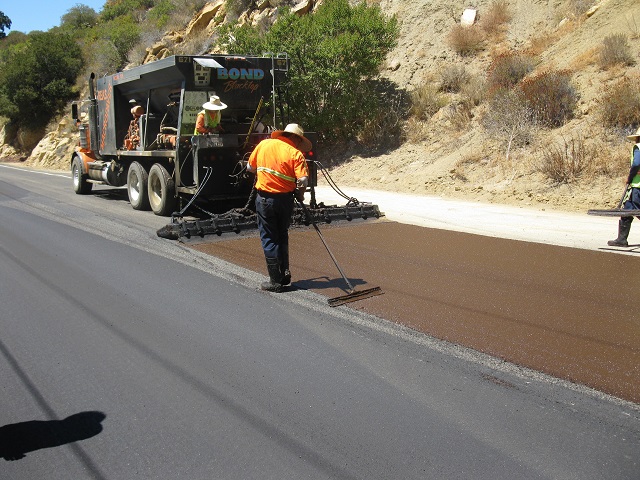What? Microsurfacing is similar to slurry seal. It consists of the application of a mixture of water, asphalt emulsion, aggregate (very small crushed rock), and chemical additives to an existing asphalt concrete pavement surface. Polymer is commonly added to the asphalt emulsion to provide better mixture properties. The major difference between slurry seal and microsurfacing is in how they “break” or harden. Slurry relies on evaporation of the water in the asphalt emulsion. The asphalt emulsion used in microsurfacing contains chemical additives which allow it to break without relying on the sun or heat for evaporation to occur. Thus, microsurfacing is an application that hardens quicker than slurry seals and can be used when conditions would not allow slurry seal to be successfully placed. Streets that have a lot of shade and streets that have a lot of traffic are good candidates for microsurfacing.
Why? Microsurfacing is applied in order to help preserve and protect the underlying pavement structure and provide a new driving surface. Roads chosen for microsurfacing application generally have low to moderate distress and narrow crack width.
When? Microsurfacing is typically applied on an intermittent, project-specific basis. Location, weather, traffic loading, and pavement conditions are factors used to determine if a microsurfacing application is appropriate. Roadways selected for microsurfacing treatment are commonly those which have slight to moderate distress, no rutting, and generally narrow crack widths, and in which a microsurfacing treatment would help extend the pavement life until resurfacing becomes necessary. Roadways chosen for cyclical microsurfacing applications would typically be treated every five to seven years.

How? Microsurfacing is commonly mixed in, and applied using, a purposely built truck, generally referred to as a “slurry truck.” If the roadway segments to be microsurfaced are long and don’t contain sharp curves, a “continuous machine” is sometimes used. This machine is capable of constant or continuous mixing and application of microsurfacing due to its large storage compartments and capability to attach to aggregate delivery trucks and tankers containing microsurfacing emulsion. This continuous operation provides the benefit of having few if any seams in the roadway which occur when operation stops.
Slurry trucks and continuous machines contain various compartments which hold the aggregate (fine crushed rock), water, polymer modified emulsion, and other additives, which are mixed in the on-board mixer. The microsurfacing mixture flows out of the rear and onto the pavement within the confines of a rear-mounted box referred to as a “micro box.” This box contains an auger which turns to uniformly distribute the mixture across the width. Workers with squeegees follow behind and assist in spreading the mixture, correcting areas not properly covered, and keeping the mixture off of concrete improvements such as gutters.
A piece of burlap is often dragged behind with the goal of producing a smooth texture while applying the microsurfacing material. The texture of microsurfacing is different than that of asphalt pavement. The texture may have faint lines and be somewhat coarse. In addition, when the microsurfacing is first placed the surface is tender and can be marked up by sudden turning movements. These impressions on the pavement are temporary as seasonal weather and traffic smooth out these imperfections over time.

Once placed microsurfacing needs 1 to 2 hours to set or harden before the road is open for traffic.
For more details, refer to SECTION 909 - MICROSURFACING of LA County Special Provisions - Section R - Roadway
Sources for more information:
LA County Special Provisions - Section R - Roadway (2015 Edition)
http://slurry.org/education/disciplinesguidelinesfaq/#Micro
http://www.cpmamerica.com/microsurfacing.htm
http://www.mdt.mt.gov/publications/docs/brochures/research/toolbox/issa/microqc.pdf
http://www.dot.ca.gov/hq/maint/MTAGChapter9-Microsurfacing.pdf